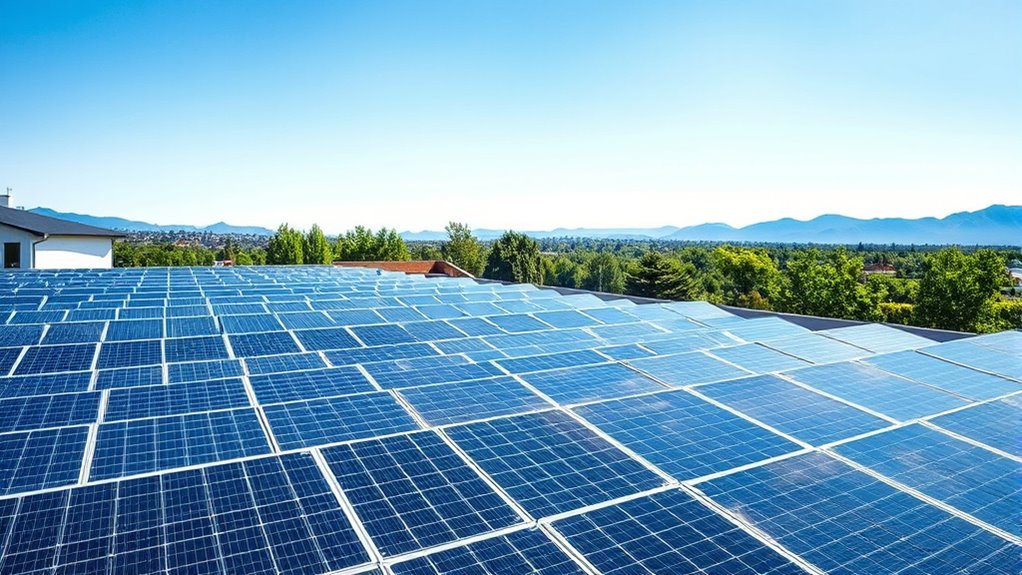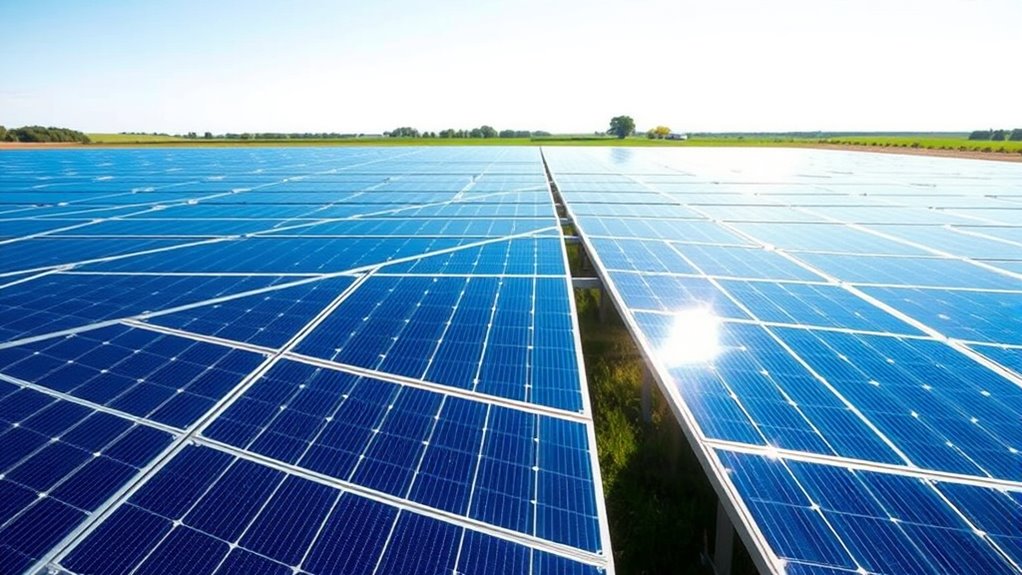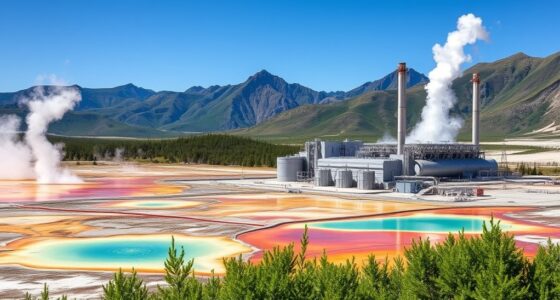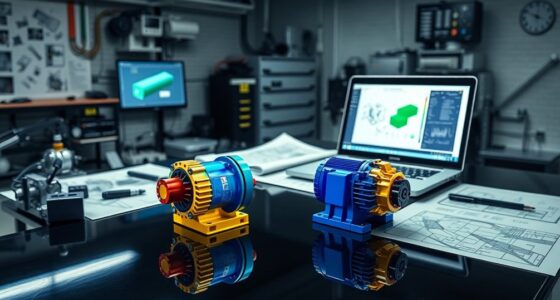Solar panels turn sunlight into clean electricity through photovoltaic cells that excite electrons to generate an electric current. This direct current (DC) is then converted into usable alternating current (AC) by inverters, so it can power your home or feed into the grid. Excess energy can be stored in batteries, providing power when the sun isn’t shining. If you explore further, you’ll discover how these advanced systems work together for a sustainable energy future.
Key Takeaways
- Sunlight activates photovoltaic cells in solar panels, exciting electrons and generating direct current (DC) electricity.
- Inverters convert DC into alternating current (AC) suitable for household and grid use.
- Excess energy can be fed into the grid or stored in batteries for later use.
- Energy management systems optimize power use, boosting efficiency and storage capabilities.
- Technological advances improve solar panel efficiency, durability, and affordability for cleaner energy production.

Have you ever wondered how sunlight can turn into electricity? It’s a fascinating process that starts with photovoltaic panels, which are made up of many solar cells. When sunlight hits these cells, it excites the electrons in the material, creating an electric current. This direct current (DC) is the foundation for generating clean energy, but it needs to be converted into alternating current (AC) for most household and grid use. That’s where inverters come into play, transforming DC into the AC power your home or business consumes.
Once the electricity is converted, it’s ready to be used or fed into the grid. This is where grid integration becomes crucial. Your solar system can supply power directly to your home, reducing reliance on the grid, or excess energy can be sent back to the utility. This process often involves net metering, which credits you for the surplus energy your system produces. Proper grid integration ensures that your solar power seamlessly interacts with the broader energy network, providing stability and reliability to both your system and the grid at large. Additionally, energy management systems are increasingly being integrated to optimize the efficiency of energy use and storage.
Proper grid integration ensures seamless, reliable solar power interaction with the energy network.
But generating electricity isn’t the whole story. Solar power systems also require effective energy storage solutions. Without energy storage, the power produced during sunny days isn’t available when the sun isn’t shining. Batteries come into play here, storing excess energy for later use—nights, cloudy days, or periods of high demand. This storage capability enhances your energy independence and ensures a steady power supply, even when the sun isn’t out. Advanced energy storage not only balances supply and demand but also helps stabilize the grid by providing backup power during outages or peak load times. Energy storage systems are continually being improved to increase efficiency and affordability.
The combination of energy storage and smart grid integration makes solar power a practical and resilient energy source. Instead of relying solely on the grid, your system can store surplus energy and draw from storage when needed, reducing your electricity bills and carbon footprint. As technology advances, these components become more efficient and affordable, making solar installations more accessible for everyone. Additionally, high-efficiency photovoltaic panels are continually being developed to maximize energy capture and output. Moreover, innovations in solar cell technology are pushing the boundaries of efficiency and durability in photovoltaic panels.
Frequently Asked Questions
How Long Do Photovoltaic Panels Typically Last Before Needing Replacement?
Photovoltaic panels typically last around 25 to 30 years, with panel longevity largely depending on quality and maintenance requirements. You should inspect and clean your panels regularly to make certain they operate efficiently. Proper maintenance can extend their lifespan, but eventually, their performance may decline, and replacement becomes necessary. Keep an eye on any drops in energy production to determine when it’s time for new panels, ensuring you continue to enjoy clean energy benefits.
Are There Environmental Impacts Associated With Manufacturing Solar Panels?
You might think solar panels are completely eco-friendly, but manufacturing them isn’t without issues. The process involves material sourcing that can harm the environment and recycling challenges when panels reach the end of their lifespan. These impacts are often overlooked, yet they matter. By understanding these environmental concerns, you can make more informed choices about adopting solar energy and supporting sustainable practices in the industry.
Can Solar Panels Operate Efficiently During Cloudy or Rainy Days?
On cloudy days, solar panels still operate with some cloudy efficiency, though their output decreases compared to sunny days. Rainy performance can also lower efficiency because the water and clouds block sunlight. However, modern panels are designed to work well in various weather conditions. You’ll find that while their performance dips, they still generate energy, making them a reliable source of clean power even when the weather isn’t perfect.
What Are the Initial Costs and Available Incentives for Solar Panel Installation?
Did you know that the average initial installation cost for solar panels ranges from $10,000 to $30,000? You can offset these costs with various financial incentives, like federal tax credits and state rebates. While installation costs vary based on system size and location, taking advantage of available incentives can markedly reduce your upfront expenses, making solar power a more affordable and attractive option for your home or business.
How Does Shading From Trees or Buildings Affect Solar Panel Performance?
Shade impact and obstruction effects considerably reduce your solar panel’s efficiency. When trees or buildings cast shadows, they block sunlight, causing parts of your panels to produce less energy. Even partial shading can decrease overall performance, as the entire system relies on each panel functioning in the best possible way. To maximize energy output, you should trim nearby trees, avoid placing panels near obstructions, and consider shading analysis before installation.
Conclusion
Now that you understand how photovoltaic panels turn sunlight into clean energy, you’re like Icarus reaching for the sun—ready to harness its power responsibly. Just as myth taught us about the importance of balance, embracing solar energy helps you contribute to a healthier planet without overreaching. With this knowledge, you’re empowered to make smarter, greener choices, shining bright like Apollo’s chariot in the sky. The future’s bright—your solar journey has just begun.









